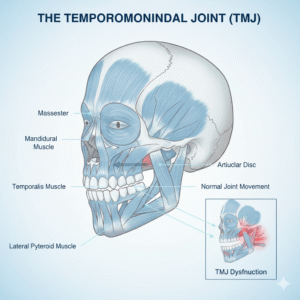
Jaw pain can be uncomfortable, distracting, and sometimes severe enough to affect daily activities like eating, speaking, or even yawning. One of the most common causes behind this discomfort is a condition known as TMJ disorder (Temporomandibular Joint Disorder). The TMJ is the joint connecting your jaw to your skull, and when it becomes irritated or misaligned, it can lead to pain, stiffness, and reduced movement.
The good news? Physiotherapy offers highly effective, non-invasive techniques to relieve jaw pain, restore function, and prevent future flare-ups.
In this article, we’ll explore what TMJ disorders are, what causes jaw pain, and the physiotherapy treatments that actually work.
What Is TMJ Disorder?
The temporomandibular joint acts like a sliding hinge that allows your jaw to open, close, chew, and speak. When this joint becomes irritated or the surrounding muscles become tight, you may develop TMJ dysfunction.
Common Symptoms of TMJ Dysfunction
-
Jaw pain or tenderness
-
Clicking, popping, or grinding sounds
-
Difficulty opening or closing the mouth
-
Facial pain or headaches
-
Ear pain or pressure
-
Pain while chewing
-
Locking of the jaw
Common Causes of Jaw Pain and TMJ Disorders
Several factors can lead to TMJ dysfunction, including:
1. Stress & Teeth Grinding (Bruxism)
Clenching or grinding your teeth—especially while sleeping—puts pressure on the TMJ.
2. Poor Posture
Forward neck posture can strain jaw muscles over time.
3. Injury or Trauma
A blow to the face or jaw can misalign the TMJ.
4. Arthritis
Inflammation in the joint can cause stiffness and pain.
5. Misaligned Bite
Dental issues can create uneven pressure on the joint.
How Physiotherapy Helps Treat TMJ Disorders
Physiotherapy plays a major role in treating TMJ by relieving muscle tension, correcting alignment, and improving jaw mechanics. Here are the most effective techniques:
1. Manual Therapy for Jaw Muscle Release
A physiotherapist uses hands-on techniques to:
-
Release tight jaw muscles
-
Reduce inflammation
-
Improve joint mobility
-
Relieve muscle spasms
Manual therapy provides immediate relief for many people with TMJ-related pain.
2. Soft Tissue Massage
Targeted massage to the masseter, temporalis, and pterygoid muscles helps reduce tightness. These muscles are often overworked due to teeth grinding or stress.
Benefits include:
-
Reduced pain
-
Increased blood flow
-
Relaxed jaw movement
3. TMJ Joint Mobilization
Gentle mobilization techniques help:
-
Realign the jaw
-
Restore smooth joint movement
-
Reduce locking or popping
This is especially beneficial for individuals with limited mouth opening.
4. Posture Correction Exercises
Poor posture, particularly forward head posture, can strain jaw muscles. Physiotherapists teach exercises that:
-
Strengthen neck and upper back muscles
-
Improve overall alignment
-
Reduce pressure on the TMJ
5. Jaw Strengthening & Relaxation Exercises
Exercises are crucial for long-term improvement. Common physiotherapy exercises include:
• Controlled mouth opening
Helps restore proper jaw movement.
• Tongue-up technique
Trains the jaw to follow a smooth motion.
• Resisted jaw opening and closing
Strengthens weak jaw muscles.
• Relaxation training
Breathing and stress management techniques help reduce clenching.
6. Ultrasound Therapy
Therapeutic ultrasound improves blood flow, reduces inflammation, and promotes healing in the TMJ region.
7. Dry Needling
For patients with severe muscle tension, dry needling can:
-
Release trigger points
-
Reduce radiating jaw and facial pain
-
Improve jaw mobility
8. Heat and Ice Therapy
Physiotherapists often recommend:
-
Heat therapy to relax muscles
-
Cold therapy to reduce inflammation and sharp pain
These simple techniques can be used at home as well.
Lifestyle Tips to Prevent TMJ Pain
To keep jaw pain from recurring, physiotherapists suggest:
-
Avoid chewing gum
-
Eat soft foods during flare-ups
-
Maintain good posture
-
Reduce stress through breathing exercises
-
Practice jaw relaxation techniques
-
Avoid resting your chin on your hand
Small changes in daily habits can make a big difference.
When to See a Physiotherapist?
You should seek professional help if you experience:
-
Persistent jaw pain
-
Clicking or popping that gets worse
-
Difficulty chewing
-
Jaw locking
-
Limited mouth opening
Early treatment ensures quicker recovery and prevents long-term problems.
Final Thoughts
Jaw pain and TMJ disorders can significantly affect your quality of life, but effective relief is possible with the right physiotherapy techniques. From manual therapy to posture correction and exercises, physiotherapy provides a safe, drug-free, and long-lasting solution to TMJ dysfunction.
If you’re experiencing jaw discomfort, consulting a trained physiotherapist is the first step toward recovery.

